Donny Caltrider contributed significant research and commentary to this article.
I was an art major at a small liberal arts college when I first learned the Green Man’s name. My friend Louis Giberson (now an art professor at Lane College), who worked primarily in sculpture, was embarking on a project to learn as much as he could about the ubiquitous foliate head that appears in temples, churches, and in public spaces across Europe and Southern Asia, but most prolifically in medieval Christian architecture. At the time, I must confess, I was not terribly interested, and it wasn’t until recently, when I happened to view the art for Magic’s Maro, that I thought to give the Green Man a deeper look.
For this, I’ve enlisted Hipsters of the Coast’s own art expert, Donny Caltrider, to assist me with exploring how Magic has made use of this famous cultural motif in its art, what the ubiquity of this ancient face has been thought to mean over the years, and what it means now.
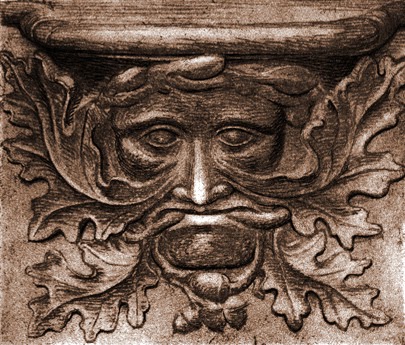
Etching of a medieval misericord; abbey-church of Vendôme, France, by Simon Garbutt
For those unfamiliar with the Green Man, the archetypal face is at least as old as the second century, and usually appears as a man’s face surrounded or otherwise integrated into foliage. Often we see what has been called a “disgorging” face, where vines or branches are growing out of his mouth. Other times, the sides of the man’s face or his facial hair is seen transforming into leaves, and more rarely his face seems simply to be emerging from the foliage. You can see these features in the Jain sculptures below, found in India.

Jain depictions of a disgorging and a foliate face, India, via Mike Harding
Interestingly, Stuart Griffon’s original Maro combines a bit of all of these features in his own composition. Perhaps the most curious thing about Griffon’s composition is its abstraction; we don’t see the Green Man as a figure, or as a part of a tree, or even as a carving or motif. This is as traditional a Green Man as we see in Magic—branches spout from it’s mouth atop a foliate head—but we also see some possible examples in Christopher Rush’s Niall Silvain and Jason Chan’s Mayael the Anima (a rare Green Woman).
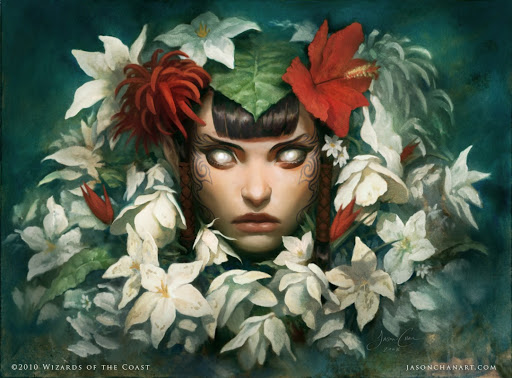
“Mayael the Anima” by Jason Chan
Despite its culture and religion transcending presence, the Green Man was seemingly just a pretty face until a 1939 article in Folklore by Lady Julia Raglan gave him a name. Her term for the verdant visage was adopted and proliferated by art historian Sir Nikolaus Pevsner of the famed Pevsner Architectural Guides and has since become more or less standard. Raglan theorized that this omnipresent bit of ecclesiastical decor was in fact a carryover of pagan fertility iconography, surmising that the presence of the Green Man in so many churches across northern Europe is a sign of a perhaps now subconscious but nevertheless enduring link to pre-Christian paganism’s connection to nature that we might perhaps re-awaken.
Lady Raglan’s theory turned out to be unfounded, but she had already solidified the Green Man’s place in the popular imagination. Raglan and others’ desire for this to be true cuts to the heart of a number of cultures’ desires to reconnect or rediscover with their pre-Christian, pre-industrial past to something ancient and pure. By the 1960s, the Green Man had been adopted by New Age spiritual and counter-cultural movements, symbolizing “all the modern world undervalues, excludes, or lacks” according to Carolyne Larrington’s The Land of the Green Man.
Josephine Livingstone notes a danger in this sentiment in her 2016 article for the New Yorker, “The Remarkable Persistence of the Green Man.” Commenting on this impulse, she notes that the “idealization of the forest as sublimely special because it does not contain people or concrete or modernity or disease represents the same impulse that pushed certain Romantics to conceive of definitive mythic pasts for their muddy, industrialized, confusing modern nations.” This desire to connect to our own roots seems particularly resonant in a time when it is easy to feel unmoored. Nevertheless, it remains an anemoia—nostalgia for a place and a time we’ve never known, longing for something far deeper than we could ever truly reach.
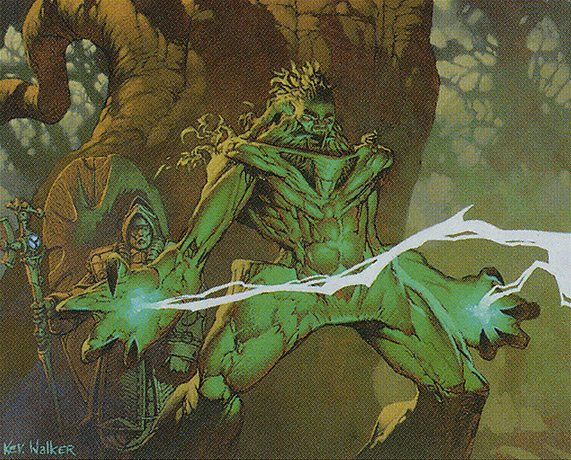
Rancor by Kev Walker
The Green Man Vengeant
In Magic we find several instances of the Green Man vengeant, which juxtaposes the traditional figure we’ve explored with the devilish qualities seen in some early carvings. Pete Venters’ Aura Mutation depicts the dark side of Multani (himself a Maro: Multani, Maro-Sorcerer), grinning in destructive pleasure as he ruptures artifice and sets loose saprolings from its ruins.
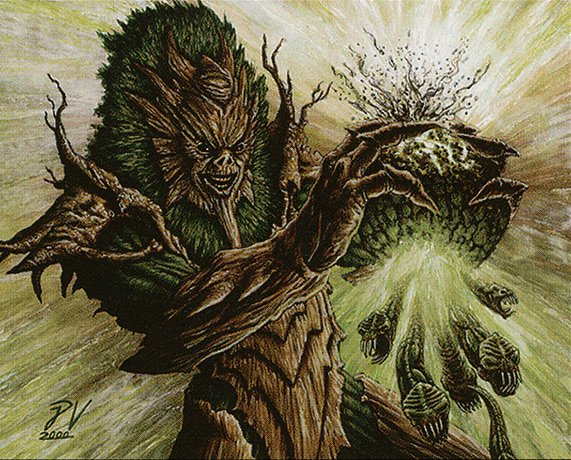
Aura Mutation by Pete Venters
Longing for a healed world has turned to show its shadow side: violent rage at the defilement of the land. For fans of The Lord of the Rings, this might bring to mind the Ents’ march against Isengard. In Magic, nowhere is this rage more obvious than on Titus Lunter’s Ancient Animus, in which Multani bursts forth in rage-filled ambush to drive out Karn, a paragon of artifice, as he seeks the Sylex. The body of Multani here isn’t even fully manifested, rising up haphazardly with so much anger-driven haste that the growth of Multani’s limbs hasn’t yet caught up to his fury.

There is seemingly no historical context in which the Green Man has been imagined as acting in quite this way, despite some carvings looking anguished or baleful. Thus, the vengeant Green Man is something uniquely adapted for its place in Magic and other fantasy media. As the aforementioned cards have shown, this isn’t a new trend, and we see another explicit example of this on one of the game’s most popular auras, Rancor. Like Ancient Animus, Rancor depicts Multani in a state of rage; functionally, it evokes the ever-imminent return of Yavimaya’s wrathful avatar.
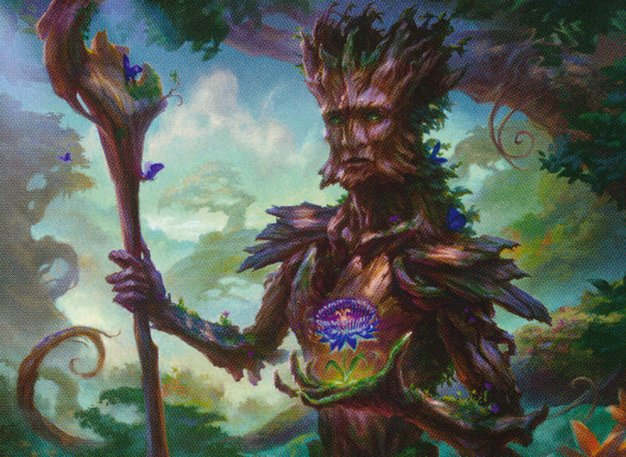
Multani, Yavimaya’s Avatar by Ryan Yee
The Green Man Reimagined
As far as the real-world Green Man is concerned, Larrington points out that “he doesn’t do anything; he has no story, no legend, except those invented for him by modern writers” (232). But this doesn’t preclude him from being a useful mythic figure. In 1939, the Green Man, as we know him now, was born into “a world which was beginning to need him, a world in which people were gradually realising how industrialisation was stealthily degrading our planet” (227). Thus, just as the Green Man has been adopted in the last half-century by a number of New Age and environmental movements in the Anglophone world, the story that Magic has invented for its own appropriation of this ancient symbol in the Maro and especially Multani, Yavimaya’s Avatar seems to track with this notion of protecting and restoring the natural world.
We see the idea of rebirth depicted both figuratively and literally through the MTG lens; for example, Ryan Yee’s Multani, Yavimaya’s Avatar holds the key to proverbial spring open in their palm, offered freely. Fittingly for Magic, it’s a lotus, one of the most recognizable symbols in the game’s history, indicative of an abundance of natural life.
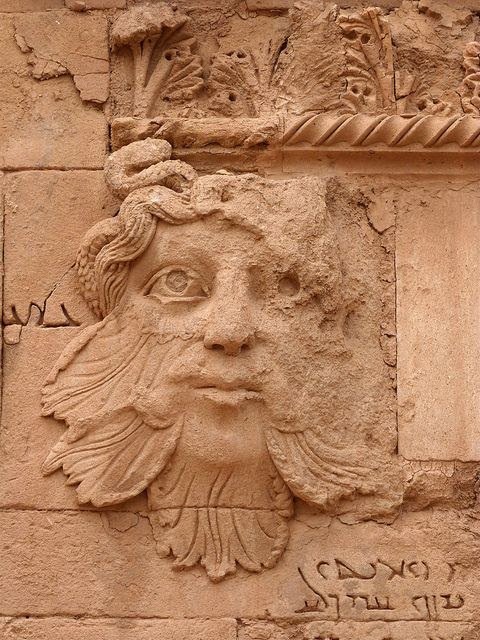
Ca. Second Century Foliate Head from the ruins of Hatra, in present-day Iraq
However, just as “No two see the same Maro,” no single reading ever exhausts the power of a symbol. That holds true here. The physical appearance of the Green Man, Larrington says, goes beyond simply encouraging ecological responsibility. The foliate face, she says, fusing man and plant, seems to insist on “that humans are inextricably part of that natural world which we in the West are so keen to subjugate” (232), undermining the same binary recently critiqued in last fortnight’s Magic & Meaning essay on Zendikar Rising.
We can see this binary thinking explicitly rejected on Rofellos’s Gift, where the elf brings an offering to the Green Man, who declines. Rather than let himself be exalted as some sort of nature god, Multani tells Rofellos, “Rise, elf. We are both of Gaea, and thus we are equal.” In her recent essay, “Black Skin, Green Masks: Medieval Foliate Heads, Racial Trauma, and Queer World-making,” NYU professor Carolyn Dinsaw adds that this idea of harmony and fusion confronts us not only with environmental questions, but questions about “who and what is deemed human, who and what is not, who decides, and what the costs of those judgments might be.”
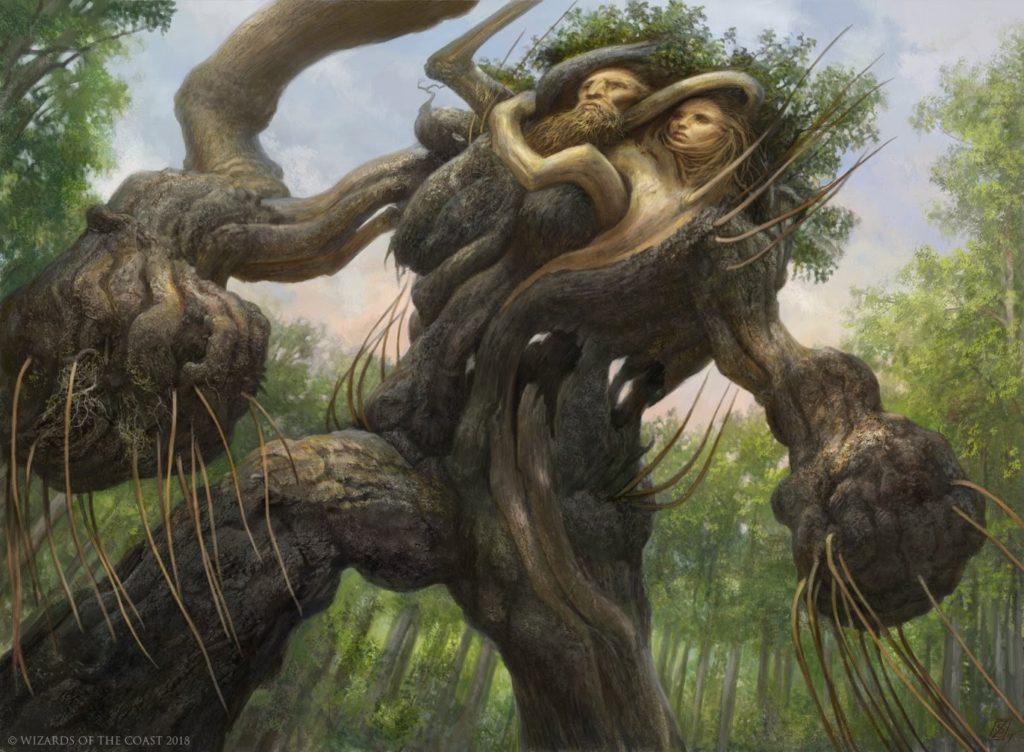
Zack Stella’s “Ghastbark Twins,” evoking the Green Man and Green Woman
Despite much of the Green Man’s recent history being the product of invention; it is precisely this invention, Dinshaw believes, that imbues the Green Man’s richness as an emblem or locus of connection between contemporary anxieties and the enduring power of myth, especially where the natural world is concerned. Magic shows us faces of Maro and Multani that take the Green Man beyond the bounds of pagan fertility deity, ward against evil, or symbol of death and rebirth. Magic transforms the Green Man into the realm of collaborator and ally in the defense and subsequent healing of the world.
Livingstone offers that current global crises push “us to think anew about the world, and the categories we apply to it. Why not choose as your aide to thought a mind-bending entity like the Green Man?” Dinshaw encourages this as well, suggesting that by “thinking with” the Green Man awhile, we might find ourselves looking out at the world and seeing a “radically enlarged field of agents,” a greening or blossoming of our own outlook that might empower us to become green ourselves, or as she poetically puts it: to: “remember histories […] sprout leaves. Breathe tendrils. Utter vines.”
Whatever that means for us, we could do worse than to pause the next time we see a face in the green—whether that’s in a park, in a church, or on a card—and contemplate what sort of blossoming might be possible for ourselves.
Recommended Media:
Donny Caltrider, “Finding Forests,” Hipsters of the Coast
Carolyne Larrington, The Land of the Green Man (Bloomsbury Academic, 2019)
Josephine Livingstone, “The Remarkable Persistence of the Green Man,” The New Yorker, March 7, 2016
Ryan Sainio, “My Favorite Forests,” Hipsters of the Coast
Type O Negative, “The Green Man”
Jacob Torbeck is a researcher and instructor of theology and ethics. He hails from Chicago, IL, and loves playing Commander and pre-modern cubes.

